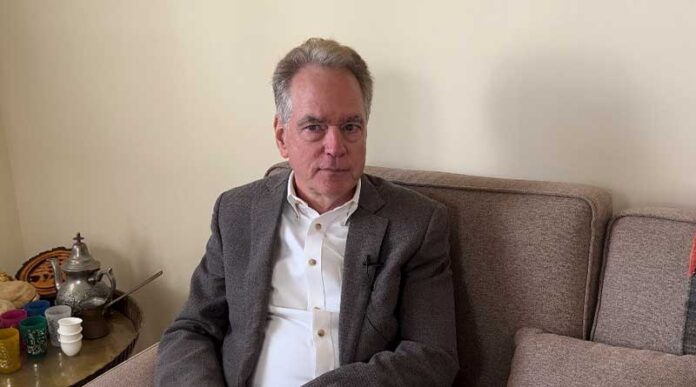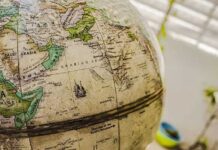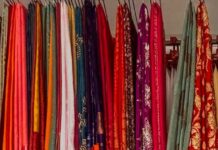By Shaikha Alshamsi
“They are trying to teach you how to fly before you know how to walk,” says David Wilmsen, an Arabic and Translation Studies professor at the American University of Sharjah.
Wilmsen was advised to learn standard Arabic or “Fusha,” which is used in religious texts, and in formal speech and writing. However, he noticed a disconnect between the formal language and the way people speak. So, he believed that learning the Arabic dialect first can be a useful approach to subsequently learning Fusha.
“They should take a dialect class, any dialect, it doesn’t matter which for an entire year to get familiar enough with their Arabic and then go on learning Fusha. But not only that, once they do that, you can use the dialect as a medium for teaching Fusha,” he adds.
He says that he wanted to teach Arabic the way native speakers acquire the language by learning it first in their homes and then joining schools to learn Fusha. This has sparked his interest in the various dialects of Arabic in the region, from Morocco to the Gulf.
The starting point:
In his first anthropology class, Wilmsen developed an interest in what anthropologists called “pastoral people” who herded animals for a living. For him, it was a starting point to learn more about certain groups of nomadic people. One of these groups was the Badu.
“There are certain examples from the dialect that are transliterated into Roman characters so that linguists who don’t know Arabic can see what’s going on.”
His interest led to his transfer to the University of Arizona to earn a master’s degree in Middle Eastern studies.
“I had done this specifically because I had decided that I wanted to study Arabic,” said Wilmsen.
However, Middle Eastern studies to him was a nowhere field since it did not give him the chance to specialize in anything. Many people in the same program were interested in politics but he was not.
“I did not want to get a degree in Middle Eastern studies and go work for the U.S. State Department. That’s one thing I know I did not want to do,” said Professor Wilmsen.
During his years at university, the professor found an opportunity to learn Arabic through a summer intensive program that was offered. In this program, the American professor began his journey of learning Gulf Arabic, the native tongue of the Khaleeji families.
In fact, the first Arabic he ever studied was the dialect of Abu Dhabi. When Wilmsen came across the Emirati dialect for the first time, he was not aware of the multiplicity of the Arabic dialects. According to him, the Emirati dialect is one of the most beautiful dialects he has ever encountered.
“When I hear it, it makes me feel good to hear it,” Wilmsen says.
The professor’s choice of learning Emirati dialects came from a fortunate incident. When Wilmsen was teaching in Lebanon, he started a long study on certain historical aspects of the development of dialects. He then became interested in the study of existential particles, such as “there was” and “there is.” The professor says that the word “shay” has not been explored thoroughly in the study of dialects.
“It was mostly associated with an old study of Omani Arabic, so I wanted to go to Oman to live there and study the dialect there or at least write a graduate proposal that would support me while I’m there doing the study,” he adds.
“There is a linguistic notation underneath each word to say what part of speech it is. If I were to gain access to a large volume of spoken data, then I would do the transcribing myself or if I had the help of graduate students, I could instruct them on how to do it.”
Wilmsen wrote a graduate proposal, which was not funded. Instead, he was offered a job at AUS. He thought that this could be an advantage for him since it was close to Oman where he could go on research trips. Nevertheless, there was a change of plan.
“When I got here, I realized that hardly anybody has done anything with studying the Emirati dialect except Hamdi Qafisheh and a few other people, only a few, but Qafisheh has done most of the work and that was in the 1970s,” he adds.
Professor Wilmsen says it was lucky for him to stay in the UAE as there are things in Emirati Arabic that are yet to be documented. The professor listens to different radio stations such as Ras Al Khaimah FM and Al Oula, a Dubai radio station, to help him with his research. He also watches television programs including a program called “Suwalif Al Awaleen,” which narrates Emirati folkloric tales from the past, to learn more about the use of Emirati dialects.
As he switches from one channel to another, Wilmsen looks for different Emirati shows he could watch to teach other professors the Emirati dialect. Before coming to the UAE in 2016, he was specifically looking for an Emirati show, which would familiarize him with the various dialects.
“It was some adjustment at first because I’ve been living in Lebanon and my wife is Jordanian and I had lived in Egypt before that, so it was having to adjust my ears to the dialect,” the professor adds.
The other access for the professor is being around Emiratis and listening to them speak and talking to them about their language. He also came across a body of recordings at the Sharjah Museum Authority, which he defined as almost classical dialectological work.
“When I first started studying the dialect, I learned how to say the word for rice, which is aish.”
“When I got here, my students told me that they could tell where someone is from as soon as they start speaking, but nobody has documented that and I would really like to be able to document some of that,” Wilmsen adds.
He started to review Qafisheh’s book to differentiate between the dialect of Abu Dhabi and Sharjah. One example of this can be seen in the use of the word “I want.” In the Abu Dhabi dialect, a person would say Ana Abghi, while in Sharjah, a person would say Ana Aba.
“It’s the same verb, but there is a slight difference in the pronunciation,” the professor says.
Wilmsen says that he had planned to create an online dialect atlas where people can take a map of the UAE and then start pointing out the differences in the dialects throughout the distinct parts of the geographical area. The atlas will show differences in vocabulary, grammar and pronunciation.
The professor says studies of the UAE were scant until the oil era. According to Wilmsen, after the expansion of the Muslim world, people from Oman and the Emirates moved to live in other places. These people lived together and ended up living in cities. When that happens, the dialects merge and a new dialect develops, and they unconsciously discard some words.
However, because of the vast distances of desert between these people and the rest of the world, the ones who stayed in their villages and towns would preserve their older way of speaking. They did not change along with other dialects.
“To me, I just find that a fascinating feature, and it’s also very comforting. It’s nice to know that people in this part of the world have retained ancient features of Arabic.”


















